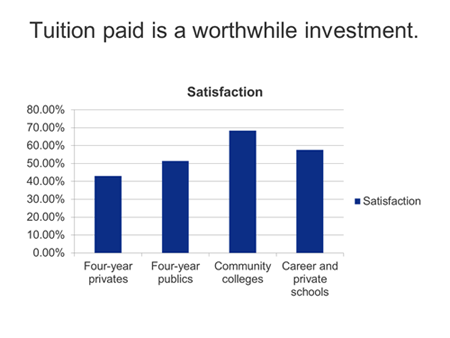enrollment
What is your tuition worth? Three suggestions for communicating the value of tuition to students
There is a lot of talk in the media about tuition inflation. On a recent edition of ABC World News, Diane Sawyer reported on 10/19/2011 that the cost of a college education is up 900 percent in the past 30 years. (An article by Larry Doyle for Business Insider offers an interesting comparison between escalating college costs and student debt with the subprime mortgage crisis, and recent data show that college tuition continues to outpace the Consumer Price Index.) The ABC News story is just another in a long stream of sound bites that students, prospective students, parents, and graduates hear that may make them question the value of their educations and the investment of tuition dollars.
The 2011 national data from the Student Satisfaction Inventory show that fewer than half of students at four-year private institutions (43 percent) are satisfied or very satisfied with their tuition being a worthwhile investment. The percentage is slightly better at four-year public institutions with 51 percent of students indicating that they are satisfied or very satisfied with this item. Students at career and private schools (which have been under a lot of scrutiny lately) report a 57 percent satisfaction score on the value of their tuition. Not surprisingly, community college students, who are usually paying the least amount per credit hour, report the highest satisfaction with their tuition investment, with 68 percent of students satisfied or very satisfied. This chart provides a visual of these scores:

This item is one that I see over and over again as a challenge item (where students express high importance and low satisfaction) on Student Satisfaction Inventory reports for four-year private and public institutions. (One side note: the responses on the parallel instrument for faculty, administration, and staff often identify this item as a strength from their perspective, illustrating why it’s a good practice to survey the perceptions of both students and campus personnel.)
What can campuses do in response? I know it is highly unlikely that tuition is going to be lowered any time soon, so colleges need to focus resources on improving the perception of the tuition paid being worthwhile. Sometimes I find that colleges try to ignore the elephant in the room by not talking about tuition, but I think it is better to address the topic in a proactive manner. Here are a couple of ideas:
1. Have a communication plan in place
Have a communication plan to inform prospective and current students (and parents of traditional students) how tuition dollars are used on campus, so everyone has a clear understanding of where the money goes. Share the big picture on your budget allocations and reflect the percentage of dollars for the key expense items like personnel and facilities. If your tuition is going up, be prepared to explain why the extra dollars are necessary and how the student experience may be improved.
2. Communicate value to current and prospective students
Communicate the value of the education you provide not only when you are recruiting new students, but when returning students are committing to their next term. Remind students of all they have access to on your campus, including but not limited to room and board, recreational facilities, Wi-Fi, library resources, in addition to top quality faculty and facilities. (Think about anything that would have a value or a fee in the “real world.”) These messages can be especially timely when students are registering for classes and when tuition payments are due.
3. Share success stories from alumni
Communicate the benefits of a degree from your institution by sharing the success stories of your alumni through on-campus workshops, testimonials, articles in the student newspaper, etc. You can involve your career services office and your alumni/development office in this process. My alma mater asked alums for photos of themselves standing in front of a sign from their place of employment or their graduate school. These photos now hang on campus in the career office and the alumni office to provide a tangible visual of what graduates of the college have been able to do with their degrees.
Many campuses are working to improve students’ awareness of the value of their college experience and to counter-balance the negative media reports. In the 15-year trend reports that we recently published, we saw satisfaction with this item increase by 6.4 percent at four-year privates and 8.6 percent at four-year publics. While there is still a long way to go, it is a move in the right direction over the past 15 years.
How are you influencing the perception of the tuition your students are paying as worthwhile? Are you ignoring the elephant in the room or are you calling attention to all of the positive aspects of your students’ tuition investment? Feel free to leave a comment below or e-mail me with any questions you have.
